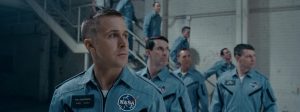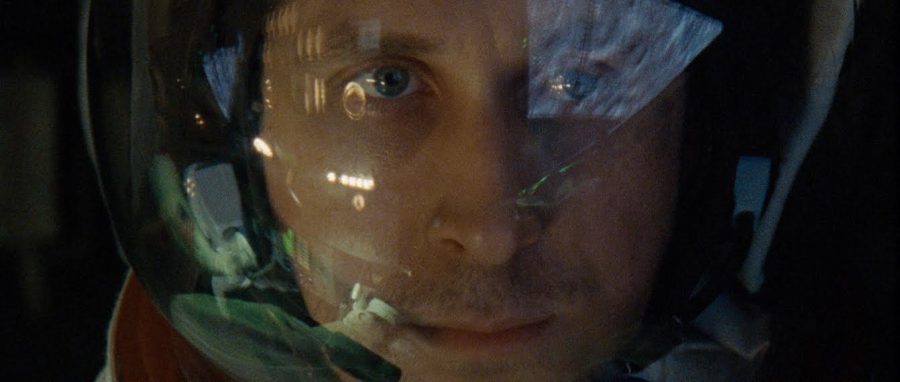In a time where the country feels more divided than ever, audiences might wax nostalgic for an era when American heroism could feel uncomplicated and bipartisan. At first glance, it seems that “First Man,” a biopic of Neil Armstrong directed by Academy Award winner Damien Chazelle, might fit the bill. For many, the Apollo 11 mission is the pinnacle of American achievement, a much-needed proof of national excellence in the midst of political and cultural tumult.
The truth of the moon landing, as “First Man” shrewdly points out, is actually more complicated. In the NASA missions leading up to Apollo 11, many questioned whether the program was worth the cost in both government dollars and human lives. In a 1970 poem incorporated into the film, poet Gil Scott-Heron lamented that poverty among black Americans was ignored while their government worked to put “whitey on the moon.” The film “First Man” itself has likewise inspired controversy. Conservative politicians and commentators criticize the movie, notably because it does not depict the famous scene of the U.S. flag being placed on the moon.
This backlash, which has received overblown media coverage before most people could even see the film, is unsubstantiated. Chazelle’s choice to leave out this scene is not politically charged — the American flag appears in plenty of other shots — and “First Man” is largely appreciative of the American space program in general and in Armstrong’s legacy in particular. What his decision does reveal is an artistic preference rather than a political one. Chazelle and his screenwriter, Josh Singer, have crafted an intimate, unexpectedly quiet film that is more interested in exploring Armstrong’s personal triumphs than making cultural commentary. The result is a subtle, delicately balanced biopic which appeals to Armstrong’s basic decency without resorting to hagiography or jingoistic propaganda.
“First Man,” which saves the Apollo 11 landing for its thrilling climax, depicts the years leading up to the famous mission. The film alternates between developments (and setbacks) within NASA and Armstrong’s personal life. Early in the film, Neil and his wife Janet (Claire Foy) bury their daughter Karen, who died at that age of two after health complications from a malignant tumor. In the film, Armstrong struggles to cope with this loss — even as his career advances, he carries emotional weight, remaining moody and distant. The film also covers key moments from the Gemini program and earlier Apollo missions, focusing on the risks, uncertainty and tragic deaths which plagued these experimental stages. Singer’s smart, if not workmanlike, screenplay draws on themes of sacrifice and ambition while emphasizing the hardships which often go unnoticed in the historically happy ending.
The film covers several narrative territories, sometimes to a fault. “First Man” is long — 138 minutes, to be exact — and often dour. Characters and events are hard to keep track of, and some of the more plot-driven sequences leave little impact. (Be warned: some advance research might be necessary if, like me, you have limited historical knowledge of American space exploration). Especially in the first two acts, the film struggles to balance the personal drama of Armstrong’s family life and the path of his career achievements.

Gosling is responsible for holding much of the film together, and he succeeds with a subdued, assured performance. He gracefully captures Armstrong’s infamous stoicism while masterfully revealing the cracks in his sober façade. He dares to imagine the ways in which Armstrong could have been difficult, even unlikable — underneath his pain, he carries a failure to empathize with the people who need him most. Gosling’s performance lacks the histrionics of typical awards show fodder, though this deficit is partially recovered by Clair Foy, a technically accomplished actress in a frustratingly conventional role.
The real star of the show is Chazelle and his cinematographer, Linus Sandgren. At age 33, Chazelle still qualifies as Hollywood’s favorite wunderkind, and in his short career he has already covered a range of thematic and stylistic realms. Though his three mainstream films — “Whiplash,” “La La Land” and “First Man” — are all entirely different, each possesses a rare visual inventiveness and confidence of vision. In “First Man,” Chazelle often uses the techniques and structure of a thriller. The flight scenes hold a visceral thrill and almost sickening intensity — by the time spacecrafts stops sputtering and shaking, it is clear that space travel is both harrowing and unglamorous. Sandgren’s cinematography, in the meanwhile, is simply awe-inspiring. His images of outer space are stunningly realistic, and he creates a sharp contrast between the warm, nostalgic glow of scenes on earth and the stark, otherworldly beauty of the moon.
Chazelle’s boldest — and most rewarding — choice comes at the climax of the film. He leaves many key moments of the moon landing completely silent, conveying the moment’s breathless awe. These scenes trust the breathtaking visuals to carry the weight of the story, and the result gives a better sense of the mission’s importance than any speechifying could. One poignant moment ties the threads between Armstrong’s personal history and the pinnacle of his work, and it packs an emotional wallop. Like the film as a whole, it could have been maudlin were it not so perfectly constructed by the filmmakers and delicately handled by Gosling. Chazelle thankfully took some useful cues from his subject — both know at pivotal moments, there is power in silence. Like Armstrong himself, “First Man” is fiercely intelligent, occasionally frustrating and genuinely inspirational.


